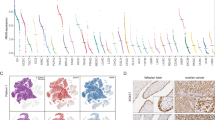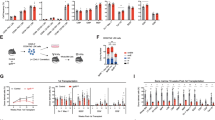Abstract
We have previously shown that MEF (myeloid ELF1-like factor, also known as ELF4) functions as a transcriptional activator of the interleukin (IL)-8, perforin, granulocyte macrophage-colony stimulating factor (GM-CSF) and IL-3 genes in hematopoietic cells. MEF is also expressed in non-hematopoietic tissues including certain ovarian cancer cells. To define the function of MEF in these cells, we examined primary human ovarian epithelial tumors and found that MEF is expressed in a significant proportion of ovarian carcinomas, and in the CAOV3 and SKOV3 ovarian cancer cell lines, but not in normal ovarian surface epithelium. Manipulating MEF levels in these cell lines altered their behavior; reducing MEF levels, using short hairpin RNA expressing vectors, significantly inhibited the proliferation of SKOV3 and CAOV3 cells in culture, and impaired the anchorage-independent growth of CAOV3 cells. Overexpression of MEF in SKOV3 cells (via retroviral transduction) significantly increased their growth rate, enhanced colony formation in soft agar and promoted tumor formation in nude mice. The oncogenic activity of MEF was further shown by the ability of MEF to transform NIH3T3 cells, and induce their tumor formation in nude mice. MEF is an important regulator of the tumorigenic properties of ovarian cancer cells and could be used a therapeutic target in ovarian cancer.
This is a preview of subscription content, access via your institution
Access options
Subscribe to this journal
Receive 50 print issues and online access
$259.00 per year
only $5.18 per issue
Buy this article
- Purchase on Springer Link
- Instant access to full article PDF
Prices may be subject to local taxes which are calculated during checkout




Similar content being viewed by others
References
Aryee DN, Petermann R, Kos K, Henn T, Haas OA, Kovar H . (1998). Cloning of a novel human ELF-1-related ETS transcription factor, ELFR, its characterization and chromosomal assignment relative to ELF-1. Gene 210: 71–78.
Choi C, Cho S, Horikawa I, Berchuck A, Wang N, Cedrone E et al. (1997). Loss of heterozygosity at chromosome segment Xq25–26.1 in advanced human ovarian carcinomas. Genes Chromosomes Cancer 20: 234–242.
Du Y, Spence SE, Jenkins NA, Copeland NG . (2005). Cooperating cancer-gene identification through oncogenic-retrovirus-induced insertional mutagenesis. Blood 106: 2498–2505.
Fukushima T, Miyazaki Y, Tsushima H, Tsutsumi C, Taguchi J, Yoshida S et al. (2003). The level of MEF but not ELF-1 correlates with FAB subtype of acute myeloid leukemia and is low in good prognosis cases. Leuk Res 27: 387–392.
Hedvat CV, Yao J, Sokolic RA, Nimer SD . (2004). Myeloid ELF1-like factor is a potent activator of interleukin-8 expression in hematopoietic cells. J Biol Chem 279: 6395–6400.
Lacorazza HD, Miyazaki Y, Di Cristofano A, Deblasio A, Hedvat C, Zhang J et al. (2002). The ETS protein MEF plays a critical role in perforin gene expression and the development of natural killer and NK-T cells. Immunity 17: 437–449.
Lacorazza HD, Nimer SD . (2003). The emerging role of the myeloid Elf-1 like transcription factor in hematopoiesis. Blood Cells Mol Dis 31: 342–350.
Lacorazza HD, Yamada T, Liu Y, Miyata Y, Sivina M, Nunes J et al. (2006). The transcription factor MEF/ELF4 regulates the quiescence of primitive hematopoietic cells. Cancer Cell 9: 175–187.
Liu Y, Hedvat CV, Mao S, Zhu XH, Yao J, Nguyen H et al. (2006). The ETS protein MEF is regulated by phosphorylation-dependent proteolysis via the protein-ubiquitin ligase SCFSkp2. Mol Cell Biol 26: 3114–3123.
Lund AH, Turner G, Trubetskoy A, Verhoeven E, Wientjens E, Hulsman D et al. (2002). Genome-wide retroviral insertional tagging of genes involved in cancer in Cdkn2a-deficient mice. Nat Genet 32: 160–165.
Mikkers H, Allen J, Knipscheer P, Romeijn L, Hart A, Vink E et al. (2002). High-throughput retroviral tagging to identify components of specific signaling pathways in cancer. Nat Genet 32: 153–159.
Milde-Langosch K, Hagen M, Bamberger AM, Loning T . (2003). Expression and prognostic value of the cell-cycle regulatory proteins, Rb, p16MTS1, p21WAF1, p27KIP1, cyclin E, and cyclin D2, in ovarian cancer. Int J Gynecol Pathol 22: 168–174.
Miyazaki Y, Boccuni P, Mao S, Zhang J, Erdjument-Bromage H, Tempst P et al. (2001). Cyclin A-dependent phosphorylation of the ETS-related protein, MEF, restricts its activity to the G1 phase of the cell cycle. J Biol Chem 276: 40528–40536.
Miyazaki Y, Sun X, Uchida H, Zhang J, Nimer S . (1996). MEF, a novel transcription factor with an Elf-1 like DNA binding domain but distinct transcriptional activating properties. Oncogene 13: 1721–1729.
Seki Y, Suico MA, Uto A, Hisatsune A, Shuto T, Isohama Y et al. (2002). The ETS transcription factor MEF is a candidate tumor suppressor gene on the X chromosome. Cancer Res 62: 6579–6586.
Seth A, Watson DK . (2005). ETS transcription factors and their emerging roles in human cancer. Eur J Cancer 41: 2462–2478.
Takai N, Miyazaki T, Nishida M, Nasu K, Miyakawa I . (2003). The significance of Elf-1 expression in epithelial ovarian carcinoma. Int J Mol Med 12: 349–354.
Tomlins SA, Rhodes DR, Perner S, Dhanasekaran SM, Mehra R, Sun XW et al. (2005). Recurrent fusion of TMPRSS2 and ETS transcription factor genes in prostate cancer. Science 310: 644–648.
Yuan ZQ, Sun M, Feldman RI, Wang G, Ma X, Jiang C et al. (2000). Frequent activation of AKT2 and induction of apoptosis by inhibition of phosphoinositide-3-OH kinase/ Akt pathway in human ovarian cancer. Oncogene 19: 2324–2330.
Acknowledgements
We thank Irina Linkov and Marina Asherov from the Immunohistochemistry core laboratory of Memorial Sloan-Kettering Cancer Center for their assistance with immunohistochemical stains. The ϕ-A-MLV and pSRαMSVtkneo plasmids were kindly provided by Owen Witte. This work was supported by the National Heart, Lung, and Blood Institute Grant K08 HL4478 (CV Hedvat), National Cancer Institute Grant K01 CA099156 (HD Lacorazza) and the National Institute of Diabetes and Digestive and Kidney Diseases Grant R01 DK052208 (SD Nimer), Ovarian Cancer PPG #CA052477 (SD Nimer) and the Produce A Cure Fund (SD Nimer).
Author information
Authors and Affiliations
Corresponding author
Additional information
Supplementary Information accompanies the paper on the Oncogene website (http://www.nature.com/onc).
Supplementary information
Rights and permissions
About this article
Cite this article
Yao, J., Liu, Y., Lacorazza, H. et al. Tumor promoting properties of the ETS protein MEF in ovarian cancer. Oncogene 26, 4032–4037 (2007). https://doi.org/10.1038/sj.onc.1210170
Received:
Revised:
Accepted:
Published:
Issue Date:
DOI: https://doi.org/10.1038/sj.onc.1210170
Keywords
This article is cited by
-
“Deficiency in ELF4, X-Linked”: a Monogenic Disease Entity Resembling Behçet’s Syndrome and Inflammatory Bowel Disease
Journal of Clinical Immunology (2024)
-
The ETS family of oncogenic transcription factors in solid tumours
Nature Reviews Cancer (2017)
-
Generation of a novel, multi-stage, progressive, and transplantable model of plasma cell neoplasms
Scientific Reports (2016)
-
Integrated analysis of microRNA-target interactions with clinical outcomes for cancers
BMC Medical Genomics (2014)
-
Promoter hypomethylation, especially around the E26 transformation-specific motif, and increased expression of poly (ADP-ribose) polymerase 1 in BRCA-mutated serous ovarian cancer
BMC Cancer (2013)



